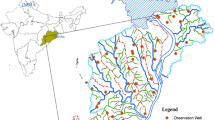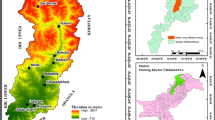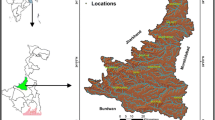Abstract
Groundwater is the largest available reservoir of freshwater. But the rapid increase in the population and urbanisation, has led to over exploitation of groundwater which imposed tremendous pressure on global groundwater resources. Because of the hidden and dynamic nature of groundwater, it requires appropriate quantification for the formulation of groundwater planning and management strategies. The present study evaluates the efficacy of geospatial technology based Multi Influence Factor (MIF), Weight of Evidence (WofE) and Frequency Ratio (FR) technique to evaluate groundwater potential using a case study of basaltic terrain. The thematic layers influencing the groundwater occurrence viz. rainfall, slope, geomorphology, soil type, land use, drainage density, lineament density, and elevation were prepared using satellite images, hydrologic, hydrogeologic and relevant field data. Based on the conceptual frameworks of MIF, WofE and FR techniques these thematic layers and their features were assigned with appropriate weight and then integrated in the ArcGIS platform for the generation of aggregated raster layer which portray the groundwater potential zones. The results of validation showed that the groundwater potential delineated using MIF technique has a prediction accuracy of 81.94%, followed by WofE technique (76.19%) and FR techniques (71.43%). It is concluded that for evaluation of groundwater potential, the MIF technique is most reliable, followed by the WofE technique. The evaluated groundwater potential zones are useful as a scientific guide to identify the suitable location of wells and recharge structure in a cost-efficient way and also for the development of structured and pragmatic groundwater management strategies.














Similar content being viewed by others
References
Achu, A. L., Thomas, J., & Reghunath, R. (2020). Multi-criteria decision analysis for delineation of groundwater potential zones in a tropical river basin using remote sensing, GIS and analytical hierarchy process (AHP). Groundwater for Sustainable Development, 10, 100365.
Adimalla, N., & Taloor, A. K. (2020). Hydrogeochemical investigation of groundwater quality in the hard rock terrain of South India using Geographic Information System (GIS) and groundwater quality index (GWQI) techniques. Groundwater for Sustainable Development, 10, 100288.
Akgun, A., Dag, S., & Bulut, F. (2008). Landslide susceptibility mapping for a landslide-prone area (Findikli, NE of Turkey) by likelihood-frequency ratio and weighted linear combination models. Environmental Geology, 54(6), 1127–1143.
Aksever, F., Davraz, A., & Karaguzel, R. (2015). Groundwater balance estimation and sustainability in the Sandıklı Basin (Afyonkarahisar/Turkey). Journal of Earth System Science, 124(4), 783–798.
Armaş, I. (2012). Weights of evidence method for landslide susceptibility mapping Prahova Subcarpathians, Romania. Natural Hazards, 60(3), 937–950.
Arulbalaji, P., Padmalal, D., & Sreelash, K. (2019). GIS and AHP techniques based delineation of groundwater potential zones: a case study from southern Western Ghats. India. Scientific Reports, 9(1), 1–17.
Asoka, A., Gleeson, T., Wada, Y., & Mishra, V. (2017). Relative contribution of monsoon precipitation and pumping to changes in groundwater storage in India. Nature Geoscience, 10(2), 109–117.
Bear, J., Cheng, A. H. D., Sorek, S., Ouazar, D., & Herrera, I. (1999). Seawater intrusion in coastal aquifers: concepts, methods and practices (Vol. 14). Springer Science & Business Media.
CGWB (2014) Groundwater Information Nashik District Maharashtra. Central Ground Water Board, 1–17. http://cgwb.gov.in/district_profile/maharashtra/nashik.pdf. Accessed 4 September 2020
CGWB (2017) Dynamic groundwater resources of India. Central Ground Water Board, G. o. I. Ministry of Jal Shakti. http://cgwb.gov.in/GW-Assessment/GWRA-2017-National-Compilation.pdf. Accessed 7 September 2020.
Cao, C., Xu, P., Wang, Y., Chen, J., Zheng, L., & Niu, C. (2016). Flash flood hazard susceptibility mapping using frequency ratio and statistical index methods in coalmine subsidence areas. Sustainability, 8(9), 948.
Chowdhury, A., Jha, M. K., Chowdary, V. M., & Mal, B. C. (2009). Integrated remote sensing and GIS-based approach for assessing groundwater potential in West Medinipur district, West Bengal. India. International Journal of Remote Sensing, 30(1), 231–250.
Corsini, A., Cervi, F., & Ronchetti, F. (2009). Weight of evidence and artificial neural networks for potential groundwater spring mapping: an application to the Mt. Modino area (Northern Apennines, Italy). Geomorphology, 111(1–2), 79–87.
Das, B., Pal, S. C., Malik, S., & Chakrabortty, R. (2019). Modeling groundwater potential zones of Puruliya district, West Bengal, India using remote sensing and GIS techniques. Geology, Ecology, and Landscapes, 3(3), 223–237.
Das, S., & Pardeshi, S. D. (2018). Integration of different influencing factors in GIS to delineate groundwater potential areas using IF and FR techniques: a study of Pravara basin, Maharashtra. India. Applied Water Science, 8(7), 197.
Devi, P. S., Srinivasulu, S., & Raju, K. K. (2001). Hydrogeomorphological and groundwater prospects of the Pageru river basin by using remote sensing data. Environmental Geology, 40(9), 1088–1094.
Fashae, O. A., Tijani, M. N., Talabi, A. O., & Adedeji, O. I. (2014). Delineation of groundwater potential zones in the crystalline basement terrain of SW-Nigeria: an integrated GIS and remote sensing approach. Applied Water Science, 4(1), 19–38.
GSI. (2001). District Resources Map. Geological Survey of India Publications Calcutta.
Ganapuram, S., Kumar, G. V., Krishna, I. M., Kahya, E., & Demirel, M. C. (2009). Mapping of groundwater potential zones in the Musi basin using remote sensing data and GIS. Advances in Engineering Software, 40(7), 506–518.
Gayen, A., & Saha, S. (2017). Application of weights-of-evidence (WoE) and evidential belief function (EBF) models for the delineation of soil erosion vulnerable zones: a study on Pathro river basin, Jharkhand. India. Modeling Earth Systems and Environment, 3(3), 1123–1139.
Ghasemi, A., Saghafian, B., & Golian, S. (2017). System dynamics approach for simulating water resources of an urban water system with emphasis on sustainability of groundwater. Environmental Earth Sciences, 76(18), 637.
Ghorbani Nejad, S., Falah, F., Daneshfar, M., Haghizadeh, A., & Rahmati, O. (2017). Delineation of groundwater potential zones using remote sensing and GIS-based data-driven models. Geocarto International, 32(2), 167–187.
Ghude, S. D., Jena, C., Chate, D. M., Beig, G., Pfister, G. G., Kumar, R., & Ramanathan, V. (2014). Reductions in India’s crop yield due to ozone. Geophysical Research Letters, 41(15), 5685–5691.
Gnanachandrasamy, G., Zhou, Y., Bagyaraj, M., Venkatramanan, S., Ramkumar, T., & Wang, S. (2018). Remote sensing and GIS based groundwater potential zone mapping in Ariyalur District, Tamil Nadu. Journal of the Geological Society of India, 92(4), 484–490.
Gumma, M. K., & Pavelic, P. (2013). Mapping of groundwater potential zones across Ghana using remote sensing, geographic information systems, and spatial modeling. Environmental Monitoring and Assessment, 185(4), 3561–3579.
Gupta, M., & Srivastava, P. K. (2010). Integrating GIS and remote sensing for identification of groundwater potential zones in the hilly terrain of Pavagarh, Gujarat. India. Water International, 35(2), 233–245.
Gurdak, J. J. (2017). Groundwater: Climate-induced pumping. Nature Geoscience, 10(2), 71–71.
Hembram, T. K., Paul, G. C., & Saha, S. (2019). Comparative analysis between morphometry and geo-environmental factor based soil erosion risk assessment using weight of evidence model: A study on jainti river basin. Eastern India. Environmental Processes, 6(4), 883–913.
Hong, H., Ilia, I., Tsangaratos, P., Chen, W., & Xu, C. (2017). A hybrid fuzzy weight of evidence method in landslide susceptibility analysis on the Wuyuan area, China. Geomorphology, 290, 1–16.
Hong, H., Tsangaratos, P., Ilia, I., Liu, J., Zhu, A. X., & Chen, W. (2018). Application of fuzzy weight of evidence and data mining techniques in construction of flood susceptibility map of Poyang County, China. Science of the Total Environment, 625, 575–588.
Jenifer, M. A., & Jha, M. K. (2017). Comparison of Analytic Hierarchy Process, Catastrophe and Entropy techniques for evaluating groundwater prospect of hard-rock aquifer systems. Journal of Hydrology, 548, 605–624.
Jha, M. K., Chowdhury, A., Chowdary, V. M., & Peiffer, S. (2007). Groundwater management and development by integrated remote sensing and geographic information systems: prospects and constraints. Water Resources Management, 21(2), 427–467.
Katpatal, Y. B., Pophare, A. M., & Lamsoge, B. R. (2014). A groundwater flow model for overexploited basaltic aquifer and Bazada formation in India. Environmental Earth Sciences, 72(11), 4413–4425.
Kaur, L., Rishi, M. S., Singh, G., & Thakur, S. N. (2020). Groundwater potential assessment of an alluvial aquifer in Yamuna sub-basin (Panipat region) using remote sensing and GIS techniques in conjunction with analytical hierarchy process (AHP) and catastrophe theory (CT). Ecological Indicators, 110, 105850.
Kayastha, P., Dhital, M. R., & De Smedt, F. (2012). Landslide susceptibility mapping using the weight of evidence method in the Tinau watershed. Nepal. Natural Hazards, 63(2), 479–498.
Kim, J. C., Jung, H. S., & Lee, S. (2019). Spatial mapping of the groundwater potential of the geum river basin using ensemble models based on remote sensing images. Remote Sensing, 11(19), 2285.
Krishnamurthy, J., Venkatesa Kumar, N., Jayaraman, V., & Manivel, M. (1996). An approach to demarcate ground water potential zones through remote sensing and a geographical information system. International Journal of Remote Sensing, 17(10), 1867–1884.
Kumar, D. P. K., Gopinath, G., & Seralathan, P. (2007). Application of remote sensing and GIS for the demarcation of groundwater potential zones of a river basin in Kerala, southwest coast of India. International Journal of Remote Sensing, 28(24), 5583–5601.
Lee, G. F., & Jones-Lee, A. (2004). Appropriate use of chemical information in a best professional judgment triad weight-of-evidence evaluation of sediment quality. Aquatic Ecosystem Health & Management, 7(3), 351–356.
Lee, S., Kim, Y. S., & Oh, H. J. (2012). Application of a weights-of-evidence method and GIS to regional groundwater productivity potential mapping. Journal of Environmental Management, 96(1), 91–105.
Lee, S., & Pradhan, B. (2007). Landslide hazard mapping at Selangor, Malaysia using frequency ratio and logistic regression models. Landslides, 4(1), 33–41.
Machiwal, D., Jha, M. K., & Mal, B. C. (2011). Assessment of groundwater potential in a semi-arid region of India using remote sensing, GIS and MCDM techniques. Water Resources Management, 25(5), 1359–1386.
Magesh, N. S., Chandrasekar, N., & Soundranayagam, J. P. (2012). Delineation of groundwater potential zones in Theni district, Tamil Nadu, using remote sensing. GIS and MIF Techniques. Geoscience Frontiers, 3(2), 189–196.
Mahmoud, S. H. (2014). Delineation of potential sites for groundwater recharge using a GIS-based decision support system. Environmental Earth Sciences, 72(9), 3429–3442.
Mohammady, M., Pourghasemi, H. R., & Amiri, M. (2019). Assessment of land subsidence susceptibility in Semnan plain (Iran): A comparison of support vector machine and weights of evidence data mining algorithms. Natural Hazards, 99(2), 951–971.
Murthy, K. S. R. (2000). Ground water potential in a semi-arid region of Andhra Pradesh-a geographical information system approach. International Journal of Remote Sensing, 21(9), 1867–1884.
Oh, H. J., Kim, Y. S., Choi, J. K., Park, E., & Lee, S. (2011). GIS mapping of regional probabilistic groundwater potential in the area of Pohang City. Korea. Journal of Hydrology, 399(3–4), 158–172.
Palmer, M. A., Reidy Liermann, C. A., Nilsson, C., Flörke, M., Alcamo, J., Lake, P. S., & Bond, N. (2008). Climate change and the world’s river basins: anticipating management options. Frontiers in Ecology and the Environment, 6(2), 81–89.
Pande, C. B., Moharir, K. N., Singh, S. K., & Varade, A. M. (2019). An integrated approach to delineate the groundwater potential zones in Devdari watershed area of Akola district, Maharashtra, Central India. Environment, Development and Sustainability, 1–21.
Parisi, A., Monno, V., & Fidelibus, M. D. (2018). Cascading vulnerability scenarios in the management of groundwater depletion and salinization in semi-arid areas. International Journal of Disaster Risk Reduction, 30, 292–305.
Pinto, D., Shrestha, S., Babel, M. S., & Ninsawat, S. (2017). Delineation of groundwater potential zones in the Comoro watershed, Timor Leste using GIS, remote sensing and analytic hierarchy process (AHP) technique. Applied Water Science, 7(1), 503–519.
Raju, R. S., Raju, G. S., & Rajasekhar, M. (2019). Identification of groundwater potential zones in Mandavi River basin, Andhra Pradesh, India using remote sensing, GIS and MIF techniques. HydroResearch, 2, 1–11.
Rane, N., & Jayaraj, G. K. (2021). Stratigraphic modeling and hydraulic characterization of a typical basaltic aquifer system in the Kadva river basin, Nashik. India. Model. Earth Syst. Environ., 7, 293–306.
Razandi, Y., Pourghasemi, H. R., Neisani, N. S., & Rahmati, O. (2015). Application of analytical hierarchy process, frequency ratio, and certainty factor models for groundwater potential mapping using GIS. Earth Science Informatics, 8(4), 867–883.
Roy, A., Keesari, T., Sinha, U. K., & Sabarathinam, C. (2019). Delineating groundwater prospect zones in a region with extreme climatic conditions using GIS and remote sensing techniques: A case study from central India. Journal of Earth System Science, 128(8), 1–19.
Sahoo, S., Jha, M. K., Kumar, N., & Chowdary, V. M. (2015). Evaluation of GIS-based multicriteria decision analysis and probabilistic modeling for exploring groundwater prospects. Environmental Earth Sciences, 74(3), 2223–2246.
Sahoo, S., Munusamy, S. B., Dhar, A., Kar, A., & Ram, P. (2017). Appraising the accuracy of multi-class frequency ratio and weights of evidence method for delineation of regional groundwater potential zones in canal command system. Water Resources Management, 31(14), 4399–4413.
Sanderson, H., Dyer, S. D., Price, B. B., Nielsen, A. M., van Compernolle, R., Selby, M., Stanton, K., Evans, A., Ciarlo, M., & Sedlak, R. (2006). Occurrence and weight-of-evidence risk assessment of alkyl sulfates, alkyl ethoxysulfates, and linear alkylbenzene sulfonates (LAS) in river water and sediments. Science of the Total Environment, 368(2–3), 695–712.
Selvakumar, S., Chandrasekar, N., Kaliraj, S., & Magesh, N. S. (2018). Salinization of shallow aquifer in the Karamaniyar river basin, Southern India. Environment, Development and Sustainability, 20(3), 1255–1273.
Shah, T. (2009). Climate change and groundwater: India’s opportunities for mitigation and adaptation. Environmental Research Letters, 4(3), 035005.
Shah, T. (2010). Taming the anarchy: Groundwater governance in South Asia. England: Routledge.
Shahid, S., Nath, S., & Roy, J. (2000). Groundwater potential modelling in a soft rock area using a GIS. International Journal of Remote Sensing, 21(9), 1919–1924.
Shahinuzzaman, M., Haque, M. N., & Shahid, S. (2021). Delineation of groundwater potential zones using a parsimonious concept based on catastrophe theory and analytical hierarchy process. Hydrogeology Journal, 1–26.
Singh, A. (2014). Groundwater resources management through the applications of simulation modeling: a review. Science of the Total Environment, 499, 414–423.
Singh, L. K., Jha, M. K., & Chowdary, V. M. (2018). Assessing the accuracy of GIS-based Multi-Criteria Decision Analysis approaches for mapping groundwater potential. Ecological Indicators, 91, 24–37.
Srinivasa Rao, Y., & Jugran, D. K. (2003). Delineation of groundwater potential zones and zones of groundwater quality suitable for domestic purposes using remote sensing and GIS. Hydrological Sciences Journal, 48(5), 821–833.
Tahmassebipoor, N., Rahmati, O., Noormohamadi, F., & Lee, S. (2016). Spatial analysis of groundwater potential using weights-of-evidence and evidential belief function models and remote sensing. Arabian Journal of Geosciences, 9(1), 79.
Tehrany, M. S., Pradhan, B., & Jebur, M. N. (2014). Flood susceptibility mapping using a novel ensemble weights-of-evidence and support vector machine models in GIS. Journal of Hydrology, 512, 332–343.
Thapa, R., Gupta, S., Gupta, A., Reddy, D. V., & Kaur, H. (2018). Use of geospatial technology for delineating groundwater potential zones with an emphasis on water-table analysis in Dwarka River basin, Birbhum. India. Hydrogeology Journal, 26(3), 899–922.
Tolche, A. D. (2021). Groundwater potential mapping using geospatial techniques: a case study of Dhungeta-Ramis sub-basin, Ethiopia. Geology, Ecology, and Landscapes, 5(1), 65–80.
Tsanis, I. K., & Apostolaki, M. G. (2009). Estimating groundwater withdrawal in poorly gauged agricultural basins. Water Resources Management, 23(6), 1097–1123.
Vasanthavigar, M., Srinivasamoorthy, K., Vijayaragavan, K., Ganthi, R. R., Chidambaram, S., Anandhan, P., Manivannan, R., & Vasudevan, S. (2010). Application of water quality index for groundwater quality assessment: Thirumanimuttar sub-basin, Tamilnadu. India. Environmental Monitoring and Assessment, 171(1–4), 595–609.
Voudouris, K. S. (2006). Groundwater balance and safe yield of the coastal aquifer system in NEastern Korinthia. Greece. Applied Geography, 26(3–4), 291–311.
Wada, Y., Van Beek, L. P., Van Kempen, C. M., Reckman, J. W., Vasak, S., & Bierkens, M. F. (2010). Global depletion of groundwater resources. Geophysical research letters. https://doi.org/10.1029/2010GL044571
Wagh, V. M., Panaskar, D. B., Muley, A. A., & Mukate, S. V. (2017). Groundwater suitability evaluation by CCME WQI model for Kadava river basin, Nashik, Maharashtra. India. Modeling Earth Systems and Environment, 3(2), 557–565.
Waikar, M. L., & Nilawar, A. P. (2014). Identification of groundwater potential zone using remote sensing and GIS technique. International Journal of Innovative Research in Science, Engineering and Technology, 3(5), 12163–12174.
Xu, C., Xu, X., Dai, F., Xiao, J., Tan, X., & Yuan, R. (2012). Landslide hazard mapping using GIS and weight of evidence model in Qingshui river watershed of 2008 Wenchuan earthquake struck region. Journal of Earth Science, 23(1), 97–120.
Yeh, H. F., Cheng, Y. S., Lin, H. I., & Lee, C. H. (2016). Mapping groundwater recharge potential zone using a GIS approach in Hualian River. Taiwan. Sustainable Environment Research, 26(1), 33–43.
Yeh, H. F., Lee, C. H., Hsu, K. C., & Chang, P. H. (2009). GIS for the assessment of the groundwater recharge potential zone. Environmental Geology, 58(1), 185–195.
Yesilnacar, M. I., Sahinkaya, E., Naz, M., & Ozkaya, B. (2008). Neural network prediction of nitrate in groundwater of Harran Plain. Turkey. Environmental Geology, 56(1), 19–25.
Zhu, Q., & Abdelkareem, M. (2021). Mapping groundwater potential zones using a knowledge-driven approach and GIS analysis. Water, 13(5), 579.
Funding
No funding was received.
Author information
Authors and Affiliations
Corresponding author
Ethics declarations
Conflicts of interest
None.
Additional information
Publisher's Note
Springer Nature remains neutral with regard to jurisdictional claims in published maps and institutional affiliations.
Rights and permissions
About this article
Cite this article
Rane, N.L., Jayaraj, G.K. Comparison of multi-influence factor, weight of evidence and frequency ratio techniques to evaluate groundwater potential zones of basaltic aquifer systems. Environ Dev Sustain 24, 2315–2344 (2022). https://doi.org/10.1007/s10668-021-01535-5
Received:
Accepted:
Published:
Issue Date:
DOI: https://doi.org/10.1007/s10668-021-01535-5




